- This topic has 13 replies, 5 voices, and was last updated 7 years ago by
 Robin Leadbeater.
Robin Leadbeater.
-
AuthorPosts
-
10 December 2018 at 12:34 am #574200
 Robin LeadbeaterParticipant
Robin LeadbeaterParticipantAttached is a raw spectrum image of Comet 46P/Wirtanen from this evening taken using the Celestron C11 and ALPY 600 spectrograph
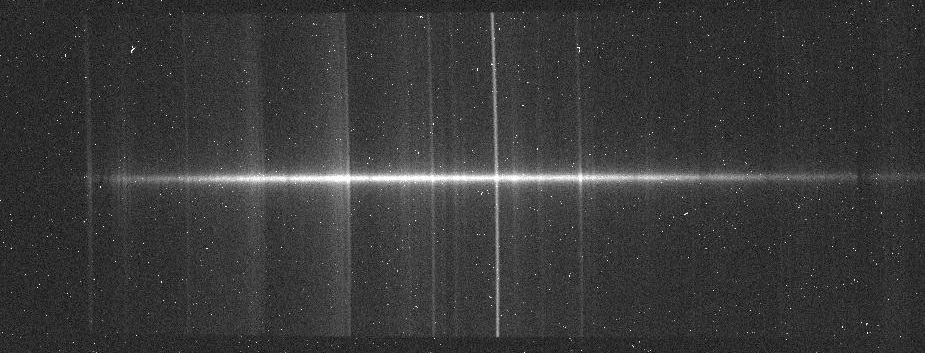
The bright horizontal line is from the very condensed (almost stellar in appearance) dusty central region, mainly a spectrum of reflected sunlight. (A solar analogue reference star was also recorded to extract the comet signature)
The diffuse outer region of the coma which extends well beyond the length of the slit (6 arcmin) shows clear Swan and other molecular bands, along with many sky lines from air glow and artificial light pollution. (which hopefully can be subtracted using separate sky measurements a couple of degrees away from the comet)
Cheers
Robin
10 December 2018 at 1:47 am #580373 Nick JamesParticipant
Nick JamesParticipantRobin, That’s a really nice demonstration of the difference betwen the gas and dust in the coma.
10 December 2018 at 3:54 pm #580374 David BoydParticipant
David BoydParticipantHere is a spectrum of comet 46P taken last night Dec 9.908 with a LISA spectrograph on a C11. Total exposure time was 3000 sec. The spectrum was integrated in the Y direction over 27 arcsec on the sky which is approximately 3x the FWHM of the bright central region of the spectrum. Sky subtraction regions were approx 3 arcmin away for the comet so although they will contain some light from the coma this is relatively faint at that distance and so should not significantly reduce the intensity of the central spectrum.
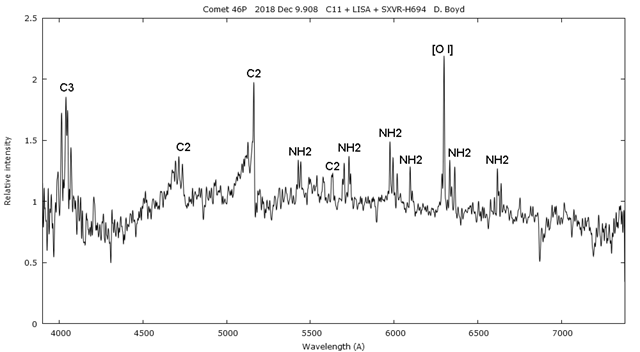
I have tentatively identified the most prominent lines using the table in Brown et al., Astronomical Journal, 112, 1197-1202 (1996). Although there is also an emission line from NH2 at 6300A, most references appear to attribute the very bright line at that wavelength to [O I].David
10 December 2018 at 4:59 pm #580375 John CoffinParticipant
John CoffinParticipantNice spectra. I tried to collect a spectrum of 38P/Stephan-Oterma last week. The spectrum of the nucleus was basically a straight line and the coma indistinguishable from the sky background spectrum from a part of the sky a few degrees away, (total exposure 4200 secs). On reflection I think I was a bit optimistic, the nucleus is mag 14.5 and the total mag is 10. I wondered if a a short focal length telescope is better for spectra of faint comets. What magnitude does a comet need to reach before it’s reasonable to expect to capture a spectrum with amateur equipment?
10 December 2018 at 7:02 pm #580376 David SwanParticipant
David SwanParticipantNice spectra, both. It is good to hear Robin that you can subtract the contribution of airglow and light pollution – if only we could all do that for all observation modalities! The comet is rapidly moving out of the worst light pollution for me and is now a) not a problem to locate in binoculars (albeit not impressive visually) b) a good imaging target with an extended coma within reach of my camera. I get a mag of 5, which is very close to Nick’s value (4.9).
10 December 2018 at 7:21 pm #580377 David BoydParticipant
David BoydParticipantThe best results will come from matching the focal ratio of the scope to that of the spectroscope, possibly using a focal reducer. In the case of the LISA that is F/5. Then it’s a matter of as much aperture as you can afford. With comets you need to be able to guide on the brightest part of the coma around the nucleus. It’s a bit of a catch 22 situation. Comets are often at their brightest when they are closest to the Earth but they will then be moving at their fastest. This will test your system’s ability to guide on a faint fast moving object. 46P was moving at about 8″/min last night which was not too bad. Even so, my system was struggling to keep in on the slit. You also ideally want a comet with a well condensed coma. 46P isn’t ideal in that respect. Although its total mag is around 9, the light is spread over an area greater than the Moon so it is very diffuse. Nevertheless the centre of 46P is till bright enough to guide on at the moment.
David
10 December 2018 at 7:51 pm #580379 John CoffinParticipant
John CoffinParticipantThat’s helpful, thanks, John
10 December 2018 at 9:55 pm #580380 Robin LeadbeaterParticipant
Robin LeadbeaterParticipantHere are my reduced spectra.
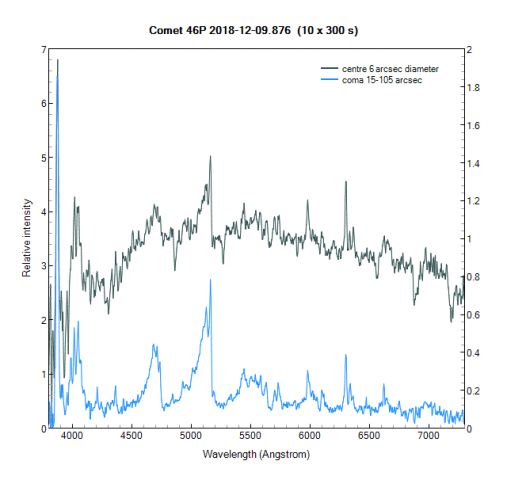
The diffuse coma integrated along the slit above and below the bright condensed region between 15 and 105 arcsec from the centre. Since the coma extended beyond the length of the slit the sky background was measured separately and subtracted. All the usual molecular components are there (CN is particularly intense in the UV) but no obvious Sodium.
The bright central region (6 arcsec diameter), again with the separately measured sky background subtracted showing the same emission components seen in the outer coma superimposed on a continuum spectrum with absorption lines.
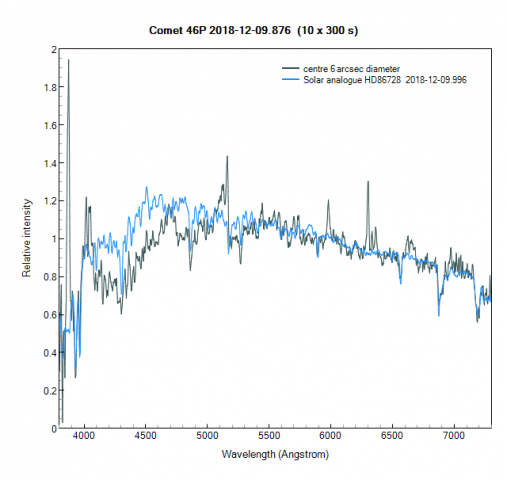
The overall shape of the continuum and the absorption features match that of the solar spectrum (here compared with a solar analogue star taken the same night), though there appears to be a lack of flux from the comet around 4000-5000A ie the reflected light from the comet is deficient in the blue part of the spectrum
Robin
11 December 2018 at 3:07 pm #580383 Robin LeadbeaterParticipant
Robin LeadbeaterParticipantI have now approximately subtracted the emission component from the spectrum of the central 6 arcsec and divided it by the solar spectrum to produce a reflectance spectrum.
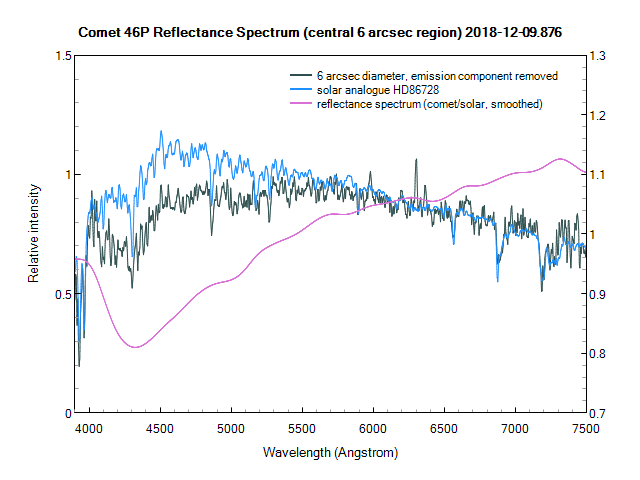
It looks similar to some asteroid reflectance spectra. Since the central region is so condensed and from images there does not appear to be much dust is it possibly representative of the comet nucleus albedo or is it just scattering from dust of a particular particle size distribution? Does anyone have a feel for how bright the nucleus would appear in reflected sunlight at this distance if not active?
Robin
11 December 2018 at 9:35 pm #580387 Nick JamesParticipant
Nick JamesParticipantGreat work from all the spectroscopists on this. The Comet Section Director is obviously going to have to learn a bit more chemistry!
Robin. I think the bare nucleus of 46P is only around 4km in diameter so you won’t be seeing anything from that. Even though most people are imaging the green Swan emission lines from gas in the coma there will be a considerable amount of dust close in. The surface brightness profile of the coma is attached. The dust will be significant in the inner part of the coma.
 12 December 2018 at 1:23 am #580388
12 December 2018 at 1:23 am #580388 Robin LeadbeaterParticipant
Robin LeadbeaterParticipantHi Nick,
A figure I have seen for the diameter of the nucleus is 1.2km so a quick back of envelope calculation using the brightness of the moon as a reference and assuming the same albedo suggests that the naked nucleus would have a brightness of ~ mag 12 currently.
(distance ratio)^2 ~1000. x (diameter ratio)^2 ~10^7 = 10^10 = ~ 25 mag + mag -13 = ~ mag 12
(corrected)
which is in the ball park of what I would have guestimated it to be from the guider image. I suspect you are right though and the nucleus is indeed hidden from view by dust.
That green channel profile includes a lot of Swan band emission. Here is a vertical slice through the spectrum in a region devoid of emission lines.
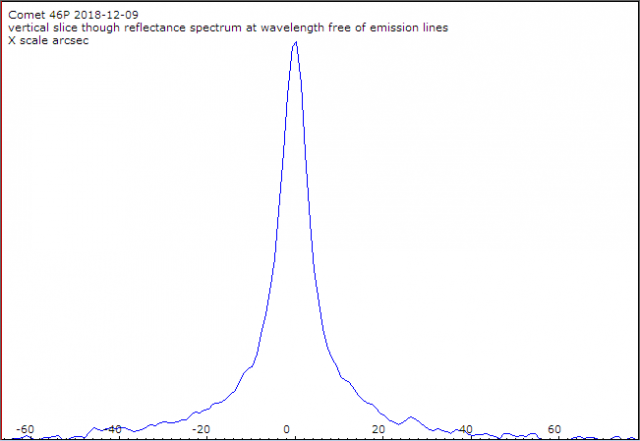
It is much narrower with the reflected/scattered component mostly confined close to the centre in a region with FWHM ~ 8arcsec. There is some spread, presumably dust, but approximately 30% of the total flux comes from a region similar in width to that produced by a star in the spectrograph which with my setup is typically ~5 arcsec FWHM (wider than a normal image due to astigmatism in the spectrograph optics and guiding errors)
Cheers
Robin
12 December 2018 at 1:52 am #580389 Robin LeadbeaterParticipant
Robin LeadbeaterParticipantI’ve found this reference for a measurement of the nucleus by the HST
http://adsabs.harvard.edu/abs/1998A&A…335L..25L
“ The color of the nucleus is moderately red with a gradient of 10% per 1000 Angstroms at optical wavelengths”
which is consistent with my measurement of the reflectance spectrum of the inner region. This is not proof that we are seeing the nucleus of course but the similarity is interesting
Robin
12 December 2018 at 7:22 am #580390 Nick JamesParticipant
Nick JamesParticipantRobin, Yes you’re right about the nucleus diameter (I was thinking it was around the same as Rosetta’s actual target, 67P, but it is quite a bit smaller. Your calculation for the bare nucleus mag is pretty good. JPL Horizons gives a nuclear mag on Dec 9 of 12.85. I get mags of 11.91V, 11.30R in an 11 arcsec diameter aperture and the R profile is definitely broader than G close in (R is mainly dust, G is mainly gas). I think you are seeing the inner dense dust cloud around the nucleus which is probably around 1.5 mags brighter than the nucleus on its own.
This plot was obtained using a widefield system with a pixel size of 2.77 arcsec.
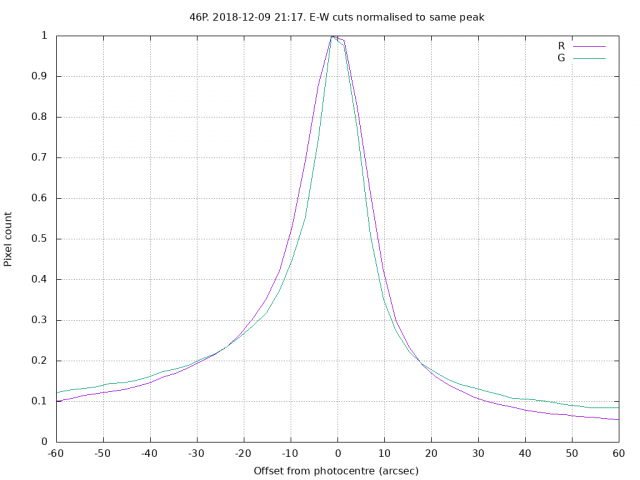 12 December 2018 at 5:12 pm #580391
12 December 2018 at 5:12 pm #580391 Robin LeadbeaterParticipant
Robin LeadbeaterParticipantThanks Nick,
Just to finally put this one to bed, I checked the reflectance spectrum in a 3 arcsec window at the centre where the nucleus would be if it were detectable and compared it with the region between 5-10 arcsec from the centre where the reflectance component is still strong but outside the nucleus. They both show the same trend of decreasing reflectance towards the blue so there is no evidence of the nucleus in the spectrum. I am a bit surprised about the dust reflectance spectrum though. I had expected perhaps the opposite trend with enhanced scattering in the blue.
Cheers
Robin
-
AuthorPosts
- You must be logged in to reply to this topic.
